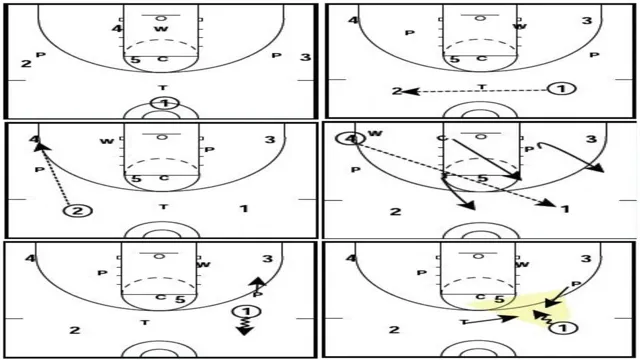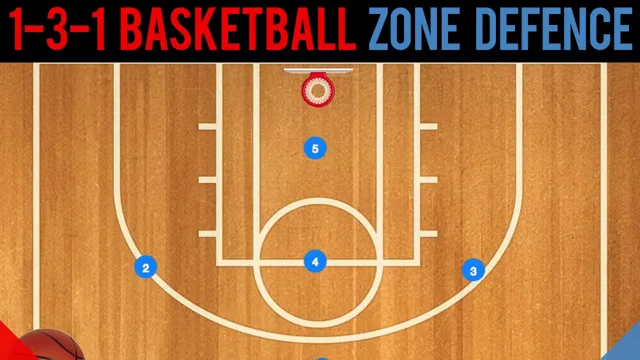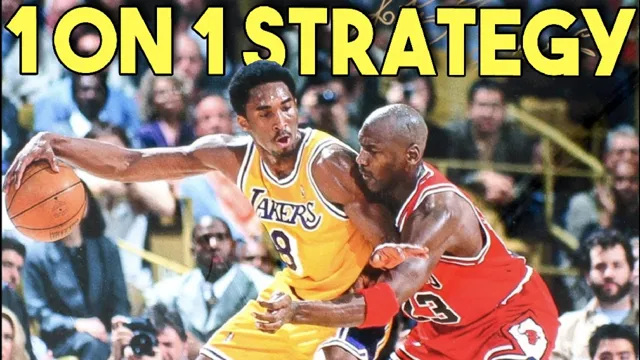If you’re a basketball fan, you’ve probably heard of the 1-3-1 defense. This defensive strategy has become increasingly popular in recent years, and for good reason. It can be an effective way to shut down your opponent’s offense and force turnovers.
In this blog post, we’ll take a closer look at the 1-3-1 defense and break down how it works. Whether you’re a coach looking to implement this strategy with your team or just a basketball enthusiast curious about different defensive strategies, we’ve got you covered. Let’s get started!
What is the 1-3-1 defense?
The 1-3-1 defense is a basketball formation that is specific to the sport and is widely used by many teams. The formation relies on having one player at the top, three players in the middle, and another player near the baseline as the strong side wing. The player at the top of the formation will typically be the point guard, while the three assigned to the middle portion are usually the two forwards and the center.
This formation is great for teams that want to maximize their defensive potential by creating space for traps and stealing opportunities. The 1-3-1 is also highly effective in confusing the opposing team’s offensive players, which forces them to make unforced errors and turnovers. Overall, the 1-3-1 defense is a versatile strategy that can help elevate a team’s defensive game on the court.
Explaining the setup and roles of each player
The 1-3-1 defense is a basketball defense strategy that involves one player being the sole defender at the top of the key, three defenders in a line along the free-throw line, and one defender positioned near the basket. This setup allows the defense to cover the court effectively, making it harder for the opposing team to penetrate the key. The player at the top of the key is responsible for stopping the point guard from dribbling into the key, while the three players along the free-throw line protect the middle area.
Meanwhile, the player guarding the basket defends against layups. It’s important for each player to communicate with their teammates, especially those near them, to ensure there are no gaps or overlaps in coverage. Overall, the 1-3-1 defense is a versatile strategy that can be adjusted to suit different situations depending on the opposing team’s tactics.

Benefits of Using the 1-3-1 Defense
If you’re looking for a basketball defense strategy that can disrupt your opponent’s offense, the 1-3-1 defense might just be what you need. This defense formation involves one player guarding the ball at the top of the key (usually the point guard), three players forming a “wall” in the middle of the court, and one player guarding the opposite wing. This formation can provide several benefits, such as forcing turnovers, trapping the ball handler, and limiting scoring opportunities from the paint.
The 1-3-1 defense is especially effective against teams with strong perimeter shooters, as it allows the defenders to contest shots while still being able to rotate quickly to close out on the ball. Overall, mastering the 1-3-1 defense requires effective communication and teamwork, but it can be a powerful tool in your basketball arsenal.
Increases pressure on opponents and causes turnovers
The 1-3-1 defense is an effective tactic in basketball as it increases pressure on opponents and often causes turnovers. This style is commonly used in the half-court and is centered around one player in the front, three in the middle, and one in the back. Its primary goal is to trap the opposing team’s point guard, forcing them into making a hasty decision that oftentimes results in a turnover.
Additionally, the 1-3-1 defense also puts pressure on passing lanes, making it difficult for the opposition to move the ball around the court. The benefit of utilizing this system is that it creates a sense of confusion and disorientation for opposing teams, making it easier to defend and causing a break in their flow. Overall, the 1-3-1 defense is a useful tool that any basketball coach should consider incorporating into their game plan.
Forces opponents to take bad shots
One of the benefits of using the 1-3-1 defense in basketball is that it forces opponents to take bad shots. This is because with the defense, the court is split into zones, with one player at the top, three players in the middle, and one player at the bottom. This can confuse the offense and disrupt their flow, making it difficult for them to execute plays and get open looks at the basket.
As a result, they may be forced to take shots from outside, or from awkward angles, leading to lower shooting percentages and giving your team a better chance to secure rebounds. By using the 1-3-1 defense, you can effectively limit your opponents’ scoring opportunities and increase your chances of winning the game.
Allows for easy transition to offense
One of the biggest benefits of using the 1-3-1 defense in basketball is its ability to quickly transition to offense. Because the defense is designed to put pressure on the ball handler and force turnovers, it often creates fast break opportunities for the defending team. This means that the team can quickly turn a defensive play into an offensive scoring opportunity.
Additionally, the 1-3-1 defense encourages players to be aggressive and take risks, which can lead to steals and overall better defensive play. Utilizing the 1-3-1 defense can give a team an advantage in both their defensive and offensive play, making it a valuable strategy to incorporate into any basketball game plan.
Implementing the 1-3-1 Defense in Your Team
If you’re looking to implement the 1-3-1 defense in your basketball team, there are a few things you need to consider. This defense is all about creating traps and forcing turnovers, while also giving your team the ability to switch quickly between a man-to-man and zone defense. The 1-3-1 defense involves one player at the top, three players in a diagonal line, and one player at the bottom.
The top player is responsible for denying the ball to the wings and forcing the ball to the sides. The three players in the diagonal line are responsible for trapping and pressuring the ball, while the bottom player is responsible for protecting the basket and rebounding. With the 1-3-1 defense, communication is key.
Your players need to be constantly talking and communicating with each other, letting each other know where the ball is and where they need to be. Overall, the 1-3-1 defense can be very effective when executed properly, and it can give your team an edge on the defensive end of the court.
Drills and strategies to prepare your team
Implementing the 1-3-1 defense in your team can be a challenging task, but with proper drills and strategies, it can be mastered. The 1-3-1 defense is a popular zone defense in basketball that can disrupt the opposition’s offensive flow. To implement it successfully, you need to start with the basics and gradually progress to more complex drills.
One effective drill is to have your team practice moving in unison to different positions on the court within the defense. You can also incorporate a “trap zone” drill, where two players in the top row of the defense trap the ball-handler while the other defenders rotate to cover passing lanes. Additionally, you can use game tape to analyze the defense and adjust it according to your team’s strengths and weaknesses.
Remember, proper communication and trust between players are critical when executing the 1-3-1 defense. By incorporating these drills and strategies, your team will be prepared to face any opponent on the court.
Adjusting the defense according to the opponent’s strengths
When it comes to defending against opponents, adjusting your defense according to their strengths is crucial. One effective defensive tactic is the 1-3-1 defense. The 1-3-1 defense is a variation of the zone defense that involves one player at the top, three players in the middle, and one player at the baseline.
This defense is particularly effective against opponents who rely heavily on their point guard or shooting guard. The player at the top of the defense can put pressure on the opposing team’s point guard, while the three players in the middle can disrupt the opposing team’s offense and force them to take outside shots. The player at the baseline is responsible for protecting the basket and rebounding missed shots.
Ultimately, implementing the 1-3-1 defense can be a game-changer for your team’s defense strategy and lead to more wins on the court.
Famous Teams That Have Used the 1-3-1 Defense
The 1-3-1 defense basketball strategy has been used by many famous teams over the years. One of the most successful teams to use this defense was the Syracuse Orange, under the leadership of coach Jim Boeheim. The Orange relied heavily on the 1-3-1 defense during their 2003 National Championship run, proving how effective it can be when executed properly.
Another successful team to use this defense was the Kansas Jayhawks, who also won a National Championship while implementing the 1-3-1 strategy. This defense is known for its ability to disrupt opposing offenses, forcing turnovers and creating fast break opportunities for the defense. It’s a complex strategy that requires coordination and communication from all five players on the court, but when executed well it can be a game-changer.
So, if you’re a basketball coach or player looking to mix up your defensive strategy, consider giving the 1-3-1 defense a try.
Success stories from high school, college, and professional leagues
The 1-3-1 defense is not a new concept in basketball. In fact, it has been used for decades by various teams in different levels of competition. Some notable teams that have successfully implemented the 1-3-1 defense include the Syracuse Orangemen, the Kansas Jayhawks, and the Minnesota Timberwolves.
At the high school level, the Plainfield North girls’ basketball team in Illinois used the 1-3-1 defense to secure a state championship in 201 In college, the Syracuse Orangemen men’s basketball team adopted the 1-3-1 zone in the early 2000s and won their first national championship in 200 The Minnesota Timberwolves used the defense during the 2003-2004 NBA season and held opponents to just 8
7 points per game, the best in the league that year. The 1-3-1 defense can be a great strategy for disrupting an opponent’s offense and forcing turnovers, but it requires precise execution and communication between players.
Conclusion
In conclusion, the 1 3 1 defense in basketball is like a game of chess, with each player carefully positioned to anticipate the opponent’s next move. It’s a coordinated effort that requires great communication, strategy, and quick thinking. So next time you see a team successfully execute the 1 3 1 defense, just remember, it’s not magic, it’s just brilliant basketball.
“
FAQs
How does a 1-3-1 defense work in basketball?
A 1-3-1 defense is a zone defense where there is one player at the top of the key, three players on the wings, and one player in the low post. The players work together to cover the court and prevent the opposing team from scoring.
When is it effective to use a 1-3-1 defense in basketball?
A 1-3-1 defense can be effective against teams that rely on perimeter shooting because the defense covers the wings and forces the opposition to either shoot from further out or pass the ball inside.
How do players in a 1-3-1 defense communicate with each other?
Communication is crucial to the success of a 1-3-1 defense. The player at the top of the key should call out switches and rotations, while the players on the wings and low post should communicate with each other to make sure there are no gaps in the defense.
What are some common weaknesses of a 1-3-1 defense in basketball?
Because a 1-3-1 defense relies on players covering specific areas of the court, it can be vulnerable to quick ball movement by the opposing team. Additionally, if the opposing team has skilled post players, they may be able to exploit the gap in coverage in the low post.


